This Insanely Fast Rocket-Powered Drone Can Almost Reach Mach 1
Engineers have successfully flown a superfast drone that can reach close to Mach 1, which is the speed of sound. The drone is able to reach these milestones thanks to a new "rotating detonation rocket engine" or RDRE attached to it. The hope is to one day attach these engines to commercial jets, making them even faster.
The test flight took place back at the end of February. The drone is roughly 8 feet long, and it weighs around 300 pounds. Venus Aerospace, the company behind the drone, flew it to an altitude of 12,000 feet aboard an Aero L-29 Delfin plane and was deployed, where the RDRE was activated, the company explained in a statement (via LiveScience).
The superfast drone then flew for ten miles at a speed of Mach 0.9, more than 680 miles per hour. It only used 80 percent of the thrust capacity of the RDRE. This successful flight is extremely important in proving the viability of the RDRE as an engine for modern jets.
Three weeks before the flight test, Venus Aerospace held a long-duration burn test to showcase the engine's viability across long flights. That was another important step in showcasing the overall viability of the engine. You can see the drone in action in a short video Venus Aerospace shared on Vimeo.
One particularly great thing about the RDRE tech is that it is around 15 percent more efficient than conventional rocket engines, the company says. As a result, it should be able to travel farther on the same amount of fuel. Some have even theorized that the engine behind the superfast drone could be 25 percent more efficient.
Obviously, there are a lot of reasons to be excited about an engine like this. Not only could it power futuristic superfast commercial jets, but it could also help with making more efficient rockets to send missions into space.
